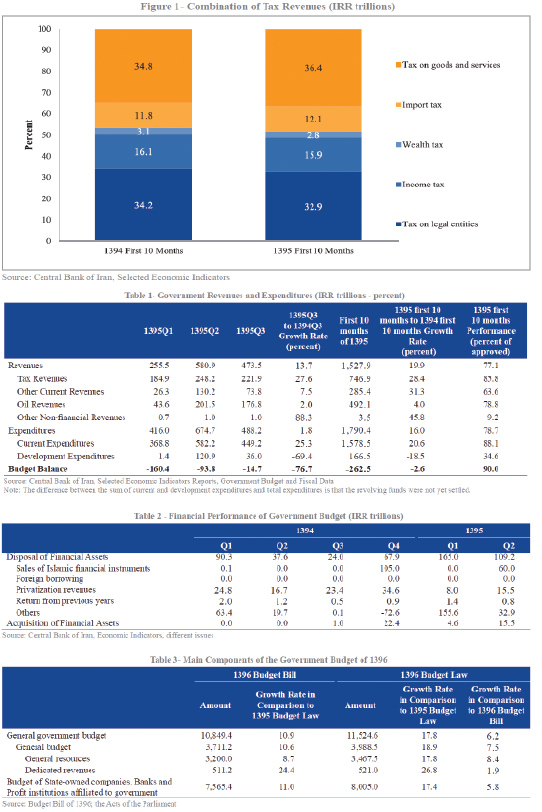Government tax revenues grew by 28.4% during the first 10 months of the previous Iranian year (started March 20, 2016) to reach 746.9 trillion rials.
This amount is below the legislated amount of 870.4 trillion rials, but its nominal growth rate is much higher than the 7.7% it experienced in the same period of 2015-16. Currently, foreign exchange rate is 1 US dollar to 37,620 rials.
Since the inflation rate in 1395 was only 9%, the real growth of tax revenues is considerable. The growth in tax revenues, in conjunction with controlling current expenditures, could have helped to either lower the budget deficit or complete unfinished development projects. But current expenditures in those 10 months rose by 20.6% and reached 1,578.5 trillion rials.
Hence, considering 285.4 trillion rials in other current revenues as well as 45.4 trillion-rial expenditures on revolving funds, the deficit in operating balance reached 591.6 trillion rials, the Middle East Bank’s latest quarterly report on Iran’s economy declared.
Regarding the net disposal of non-financial assets, government oil revenues dropped by 4% and reached 492.1 trillion rials in the 10-month period. This contraction may seem surprising, given the jump in the value of oil exports, but the government had previously spent a proportion of oil revenues to settle its debt to the Central Bank of Iran and the latter amount is not reflected in oil revenues.
This debt to CBI is rooted in the government’s wish to cover the shortage in oil revenues by March 2016, thereby over-reporting oil revenues in this period.
Development expenditures fell by 18.5% and reached 166.5 trillion rials over the period. Considering 3.5 trillion-rial as other revenues from the disposal of non-financial assets, the net disposal of non-financial assets amounted to 329.1 trillion rials in this period, which is much lower than the operating balance deficit.
Therefore, the government’s budget deficit reached 262.5 trillion rials in this period.
Table 1 shows the government’s fiscal performance during the 10 months.
Budget deficit amounted to 254.1 trillion rials in the first half of the last Iranian year.
By adding 20.1 trillion rials spent on the acquisition of financial assets to the budget deficit, financial assets worth 274.2 trillion rials were disposed in the same six months, out of which the selling of Islamic securities accounted for 60 trillion rials.
Table 2 exhibits statistics on the financial performance of government budget in 2015-16 and 2016-17.
Raising tax revenues in the presence of recession may well hinder economic growth. Details of the tax revenues show that the government has relied more on indirect taxation than on direct taxation. This is consistent with the 33.6% increase in indirect tax revenues and 23.9% increase in direct tax revenues in the 10 months of the last Iranian year.
An examination of revenues from indirect taxation reveals that taxes on imports rose by 31.5% and taxes on goods and services by 34.4% in the same period.
Revenues from value-added taxes rose by only 3.0% and its share in total tax revenues declined by 5.7 percentage points to 23.1% in this period. Figure 1 exhibits the share of various components of tax revenues in the 10 months of the last two years.
Expectations
The Budget Law for 2017-18 was approved by the parliament in March 2017.
Table 3 compares major items in the budget laws of the current and last Iranian years.
Figures in the budget bill were in line with expectations for a 10% inflation rate. However, the parliament raised the figures higher than the projected inflation rate, thereby strengthening the role of the government in the economy.
The current budget is 6.2% higher than the previous budget and almost 18% higher than the previous year’s budget.
General sources and uses rose by 8.4% in the budget compared to the figure in the budget bill of 1396, while the share of government in oil revenues diminished at the expense of increasing the share of National Development Fund of Iran from 20-30% called for by the sixth five-year development plan (2017-22). The government is thus expected to be under pressure to finance its current expenditures via taxation and the sale of Islamic securities, thereby deviating further from the legislated figures in the budget.


